ACC4029 - Operations & Finance: Strategic Analysis of Cucumber Ltd
VerifiedAdded on 2023/04/21
|12
|3548
|494
Report
AI Summary
This report evaluates Cucumber Ltd's expansion plans using capital investment techniques, analyzing four proposals and recommending the most suitable option. It discusses the role of management accounting, business plans, and budgets in operational effectiveness. A balanced scorecard is developed to assess the company's performance based on the provided case study information. The analysis includes payback period, net present value (NPV), and internal rate of return (IRR) methods to determine the optimal investment strategy. Ultimately, the report recommends investing in proposal 4 due to its highest NPV and favorable internal rate of return. This document is available on Desklib, a platform providing a wide array of study tools and solved assignments for students.
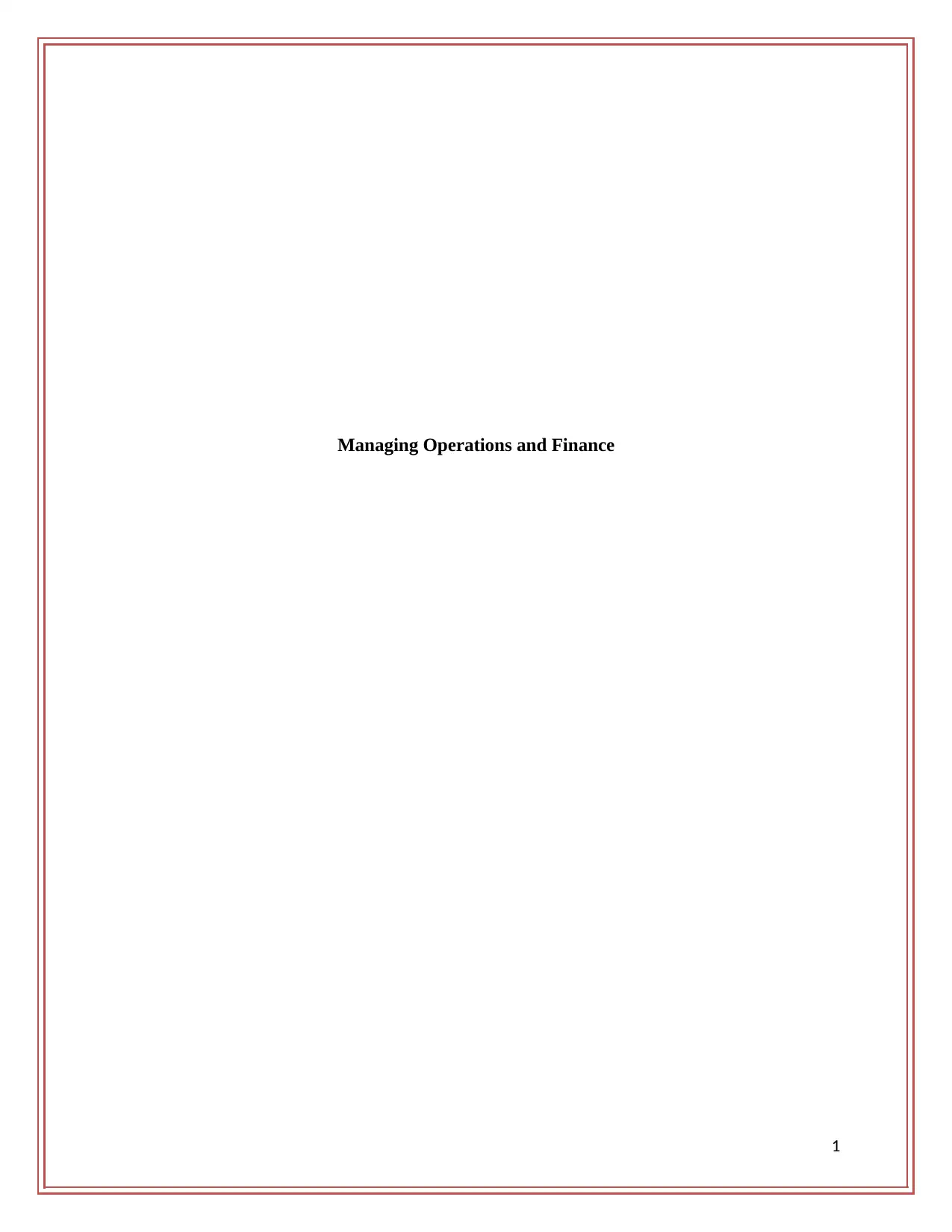
Managing Operations and Finance
1
1
Secure Best Marks with AI Grader
Need help grading? Try our AI Grader for instant feedback on your assignments.
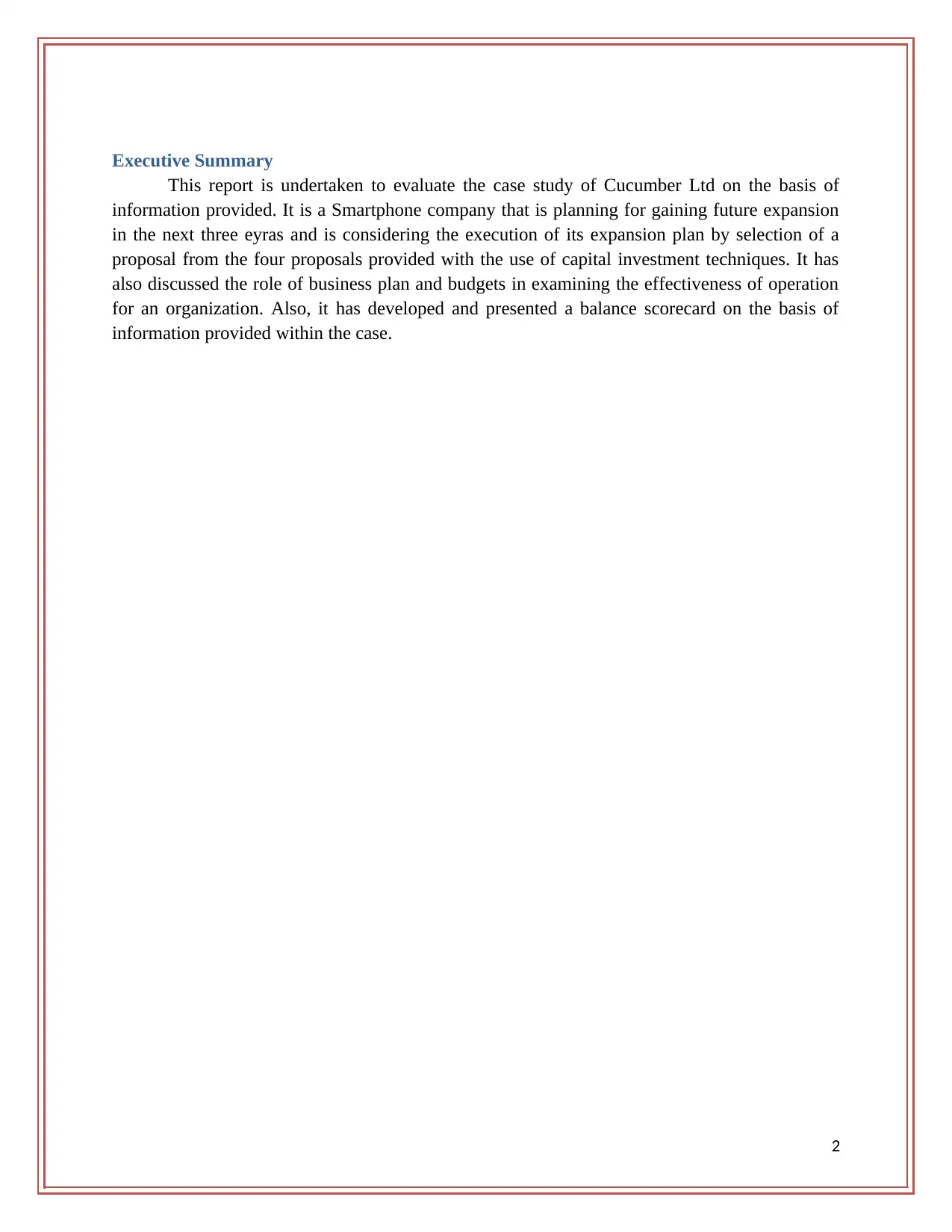
Executive Summary
This report is undertaken to evaluate the case study of Cucumber Ltd on the basis of
information provided. It is a Smartphone company that is planning for gaining future expansion
in the next three eyras and is considering the execution of its expansion plan by selection of a
proposal from the four proposals provided with the use of capital investment techniques. It has
also discussed the role of business plan and budgets in examining the effectiveness of operation
for an organization. Also, it has developed and presented a balance scorecard on the basis of
information provided within the case.
2
This report is undertaken to evaluate the case study of Cucumber Ltd on the basis of
information provided. It is a Smartphone company that is planning for gaining future expansion
in the next three eyras and is considering the execution of its expansion plan by selection of a
proposal from the four proposals provided with the use of capital investment techniques. It has
also discussed the role of business plan and budgets in examining the effectiveness of operation
for an organization. Also, it has developed and presented a balance scorecard on the basis of
information provided within the case.
2
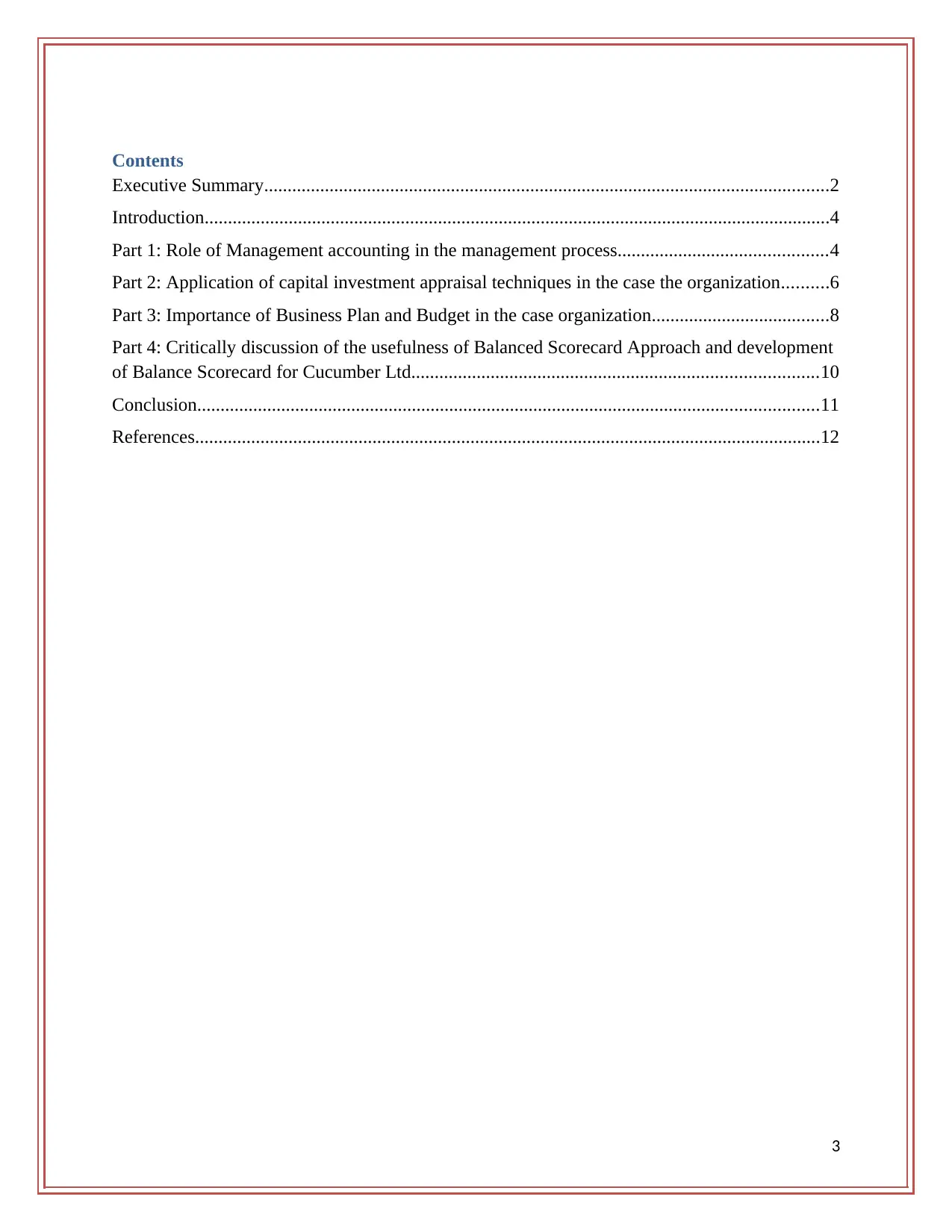
Contents
Executive Summary.........................................................................................................................2
Introduction......................................................................................................................................4
Part 1: Role of Management accounting in the management process.............................................4
Part 2: Application of capital investment appraisal techniques in the case the organization..........6
Part 3: Importance of Business Plan and Budget in the case organization......................................8
Part 4: Critically discussion of the usefulness of Balanced Scorecard Approach and development
of Balance Scorecard for Cucumber Ltd.......................................................................................10
Conclusion.....................................................................................................................................11
References......................................................................................................................................12
3
Executive Summary.........................................................................................................................2
Introduction......................................................................................................................................4
Part 1: Role of Management accounting in the management process.............................................4
Part 2: Application of capital investment appraisal techniques in the case the organization..........6
Part 3: Importance of Business Plan and Budget in the case organization......................................8
Part 4: Critically discussion of the usefulness of Balanced Scorecard Approach and development
of Balance Scorecard for Cucumber Ltd.......................................................................................10
Conclusion.....................................................................................................................................11
References......................................................................................................................................12
3
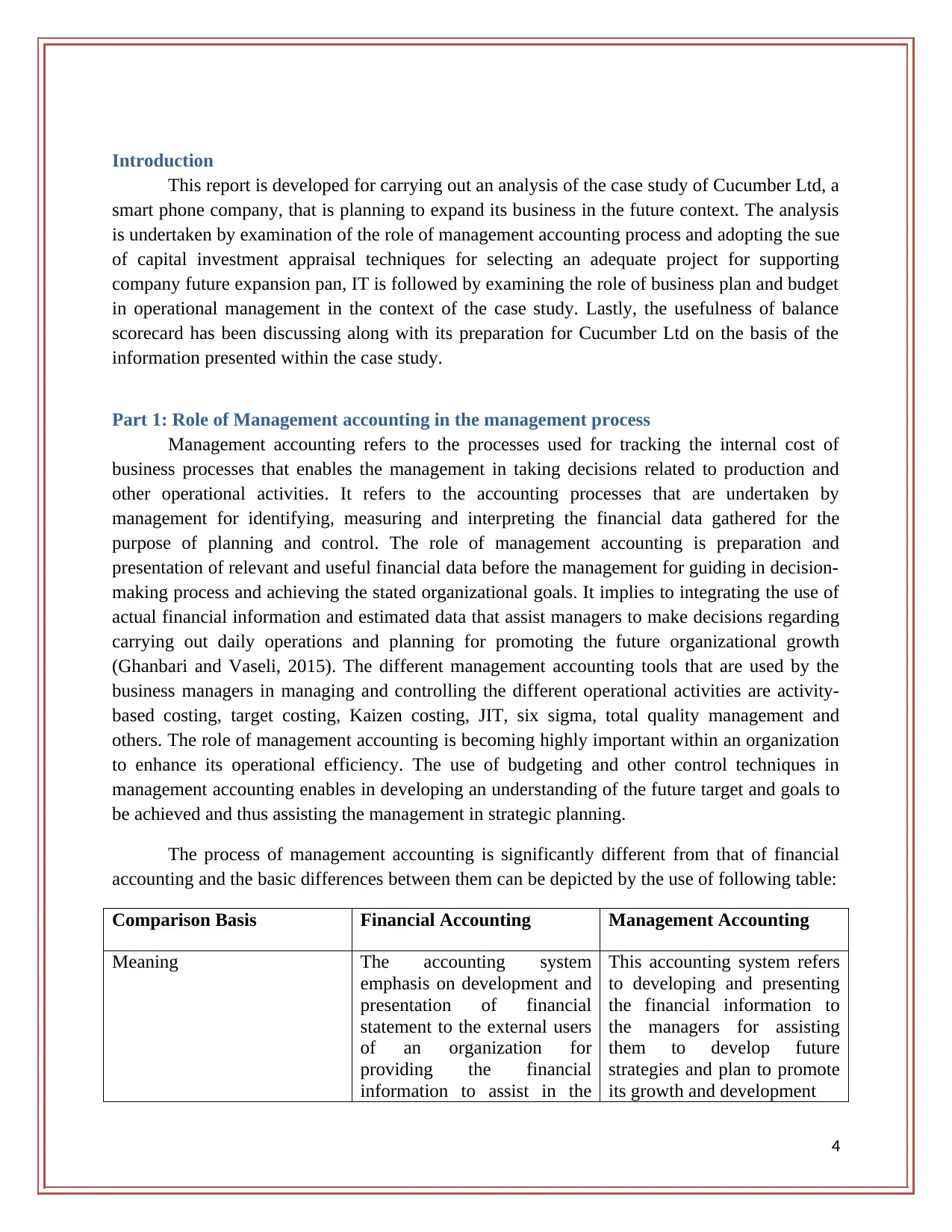
Introduction
This report is developed for carrying out an analysis of the case study of Cucumber Ltd, a
smart phone company, that is planning to expand its business in the future context. The analysis
is undertaken by examination of the role of management accounting process and adopting the sue
of capital investment appraisal techniques for selecting an adequate project for supporting
company future expansion pan, IT is followed by examining the role of business plan and budget
in operational management in the context of the case study. Lastly, the usefulness of balance
scorecard has been discussing along with its preparation for Cucumber Ltd on the basis of the
information presented within the case study.
Part 1: Role of Management accounting in the management process
Management accounting refers to the processes used for tracking the internal cost of
business processes that enables the management in taking decisions related to production and
other operational activities. It refers to the accounting processes that are undertaken by
management for identifying, measuring and interpreting the financial data gathered for the
purpose of planning and control. The role of management accounting is preparation and
presentation of relevant and useful financial data before the management for guiding in decision-
making process and achieving the stated organizational goals. It implies to integrating the use of
actual financial information and estimated data that assist managers to make decisions regarding
carrying out daily operations and planning for promoting the future organizational growth
(Ghanbari and Vaseli, 2015). The different management accounting tools that are used by the
business managers in managing and controlling the different operational activities are activity-
based costing, target costing, Kaizen costing, JIT, six sigma, total quality management and
others. The role of management accounting is becoming highly important within an organization
to enhance its operational efficiency. The use of budgeting and other control techniques in
management accounting enables in developing an understanding of the future target and goals to
be achieved and thus assisting the management in strategic planning.
The process of management accounting is significantly different from that of financial
accounting and the basic differences between them can be depicted by the use of following table:
Comparison Basis Financial Accounting Management Accounting
Meaning The accounting system
emphasis on development and
presentation of financial
statement to the external users
of an organization for
providing the financial
information to assist in the
This accounting system refers
to developing and presenting
the financial information to
the managers for assisting
them to develop future
strategies and plan to promote
its growth and development
4
This report is developed for carrying out an analysis of the case study of Cucumber Ltd, a
smart phone company, that is planning to expand its business in the future context. The analysis
is undertaken by examination of the role of management accounting process and adopting the sue
of capital investment appraisal techniques for selecting an adequate project for supporting
company future expansion pan, IT is followed by examining the role of business plan and budget
in operational management in the context of the case study. Lastly, the usefulness of balance
scorecard has been discussing along with its preparation for Cucumber Ltd on the basis of the
information presented within the case study.
Part 1: Role of Management accounting in the management process
Management accounting refers to the processes used for tracking the internal cost of
business processes that enables the management in taking decisions related to production and
other operational activities. It refers to the accounting processes that are undertaken by
management for identifying, measuring and interpreting the financial data gathered for the
purpose of planning and control. The role of management accounting is preparation and
presentation of relevant and useful financial data before the management for guiding in decision-
making process and achieving the stated organizational goals. It implies to integrating the use of
actual financial information and estimated data that assist managers to make decisions regarding
carrying out daily operations and planning for promoting the future organizational growth
(Ghanbari and Vaseli, 2015). The different management accounting tools that are used by the
business managers in managing and controlling the different operational activities are activity-
based costing, target costing, Kaizen costing, JIT, six sigma, total quality management and
others. The role of management accounting is becoming highly important within an organization
to enhance its operational efficiency. The use of budgeting and other control techniques in
management accounting enables in developing an understanding of the future target and goals to
be achieved and thus assisting the management in strategic planning.
The process of management accounting is significantly different from that of financial
accounting and the basic differences between them can be depicted by the use of following table:
Comparison Basis Financial Accounting Management Accounting
Meaning The accounting system
emphasis on development and
presentation of financial
statement to the external users
of an organization for
providing the financial
information to assist in the
This accounting system refers
to developing and presenting
the financial information to
the managers for assisting
them to develop future
strategies and plan to promote
its growth and development
4
Secure Best Marks with AI Grader
Need help grading? Try our AI Grader for instant feedback on your assignments.
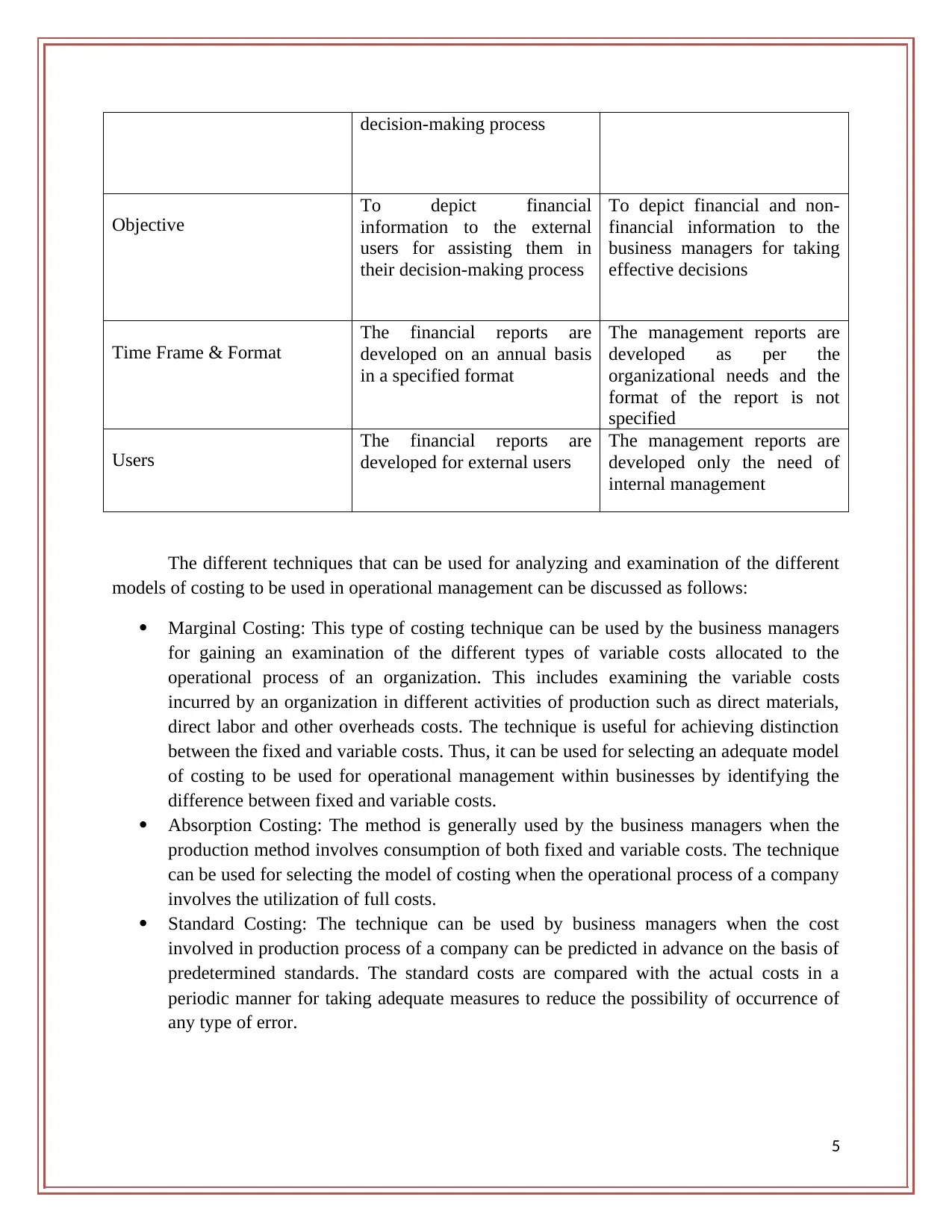
decision-making process
Objective
To depict financial
information to the external
users for assisting them in
their decision-making process
To depict financial and non-
financial information to the
business managers for taking
effective decisions
Time Frame & Format
The financial reports are
developed on an annual basis
in a specified format
The management reports are
developed as per the
organizational needs and the
format of the report is not
specified
Users
The financial reports are
developed for external users
The management reports are
developed only the need of
internal management
The different techniques that can be used for analyzing and examination of the different
models of costing to be used in operational management can be discussed as follows:
Marginal Costing: This type of costing technique can be used by the business managers
for gaining an examination of the different types of variable costs allocated to the
operational process of an organization. This includes examining the variable costs
incurred by an organization in different activities of production such as direct materials,
direct labor and other overheads costs. The technique is useful for achieving distinction
between the fixed and variable costs. Thus, it can be used for selecting an adequate model
of costing to be used for operational management within businesses by identifying the
difference between fixed and variable costs.
Absorption Costing: The method is generally used by the business managers when the
production method involves consumption of both fixed and variable costs. The technique
can be used for selecting the model of costing when the operational process of a company
involves the utilization of full costs.
Standard Costing: The technique can be used by business managers when the cost
involved in production process of a company can be predicted in advance on the basis of
predetermined standards. The standard costs are compared with the actual costs in a
periodic manner for taking adequate measures to reduce the possibility of occurrence of
any type of error.
5
Objective
To depict financial
information to the external
users for assisting them in
their decision-making process
To depict financial and non-
financial information to the
business managers for taking
effective decisions
Time Frame & Format
The financial reports are
developed on an annual basis
in a specified format
The management reports are
developed as per the
organizational needs and the
format of the report is not
specified
Users
The financial reports are
developed for external users
The management reports are
developed only the need of
internal management
The different techniques that can be used for analyzing and examination of the different
models of costing to be used in operational management can be discussed as follows:
Marginal Costing: This type of costing technique can be used by the business managers
for gaining an examination of the different types of variable costs allocated to the
operational process of an organization. This includes examining the variable costs
incurred by an organization in different activities of production such as direct materials,
direct labor and other overheads costs. The technique is useful for achieving distinction
between the fixed and variable costs. Thus, it can be used for selecting an adequate model
of costing to be used for operational management within businesses by identifying the
difference between fixed and variable costs.
Absorption Costing: The method is generally used by the business managers when the
production method involves consumption of both fixed and variable costs. The technique
can be used for selecting the model of costing when the operational process of a company
involves the utilization of full costs.
Standard Costing: The technique can be used by business managers when the cost
involved in production process of a company can be predicted in advance on the basis of
predetermined standards. The standard costs are compared with the actual costs in a
periodic manner for taking adequate measures to reduce the possibility of occurrence of
any type of error.
5
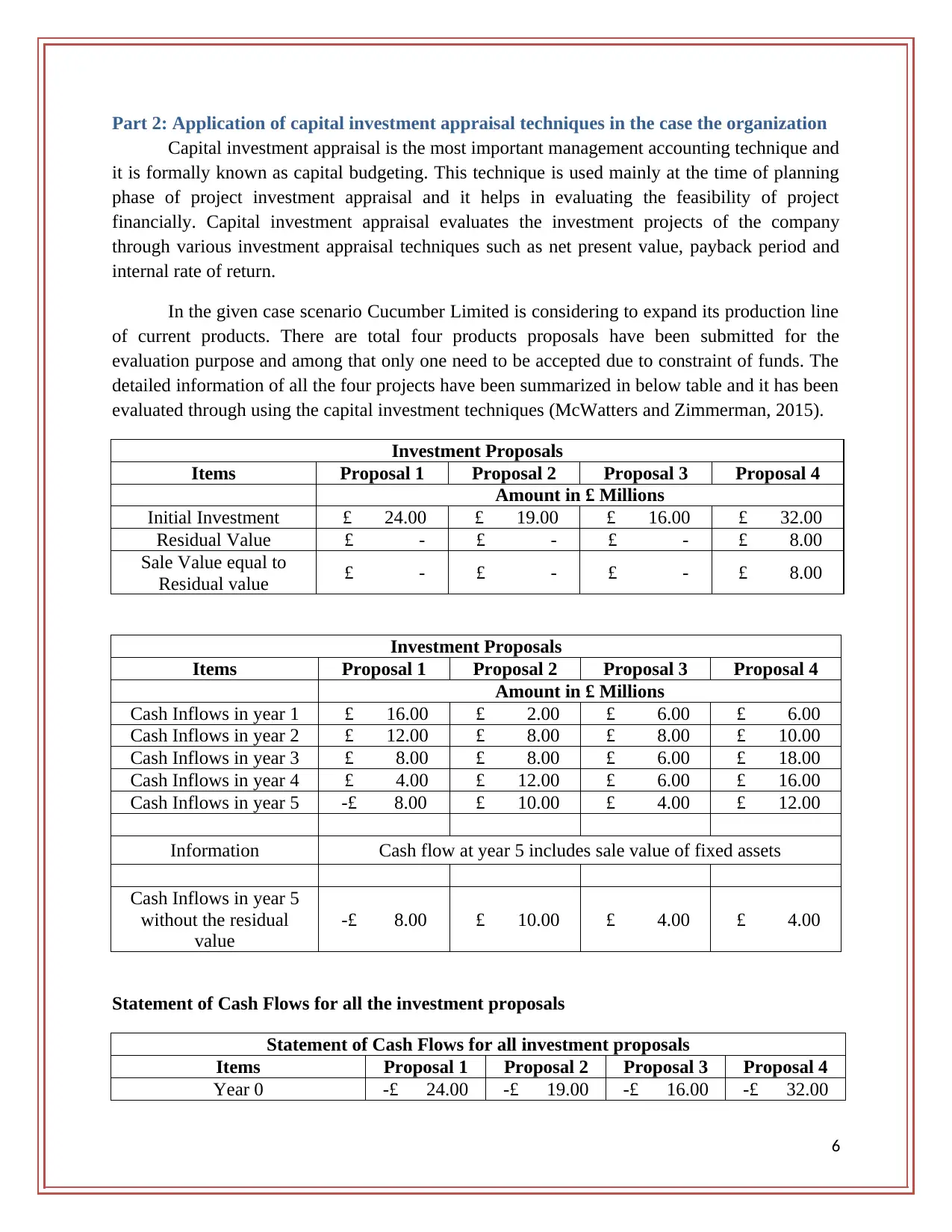
Part 2: Application of capital investment appraisal techniques in the case the organization
Capital investment appraisal is the most important management accounting technique and
it is formally known as capital budgeting. This technique is used mainly at the time of planning
phase of project investment appraisal and it helps in evaluating the feasibility of project
financially. Capital investment appraisal evaluates the investment projects of the company
through various investment appraisal techniques such as net present value, payback period and
internal rate of return.
In the given case scenario Cucumber Limited is considering to expand its production line
of current products. There are total four products proposals have been submitted for the
evaluation purpose and among that only one need to be accepted due to constraint of funds. The
detailed information of all the four projects have been summarized in below table and it has been
evaluated through using the capital investment techniques (McWatters and Zimmerman, 2015).
Investment Proposals
Items Proposal 1 Proposal 2 Proposal 3 Proposal 4
Amount in £ Millions
Initial Investment £ 24.00 £ 19.00 £ 16.00 £ 32.00
Residual Value £ - £ - £ - £ 8.00
Sale Value equal to
Residual value £ - £ - £ - £ 8.00
Investment Proposals
Items Proposal 1 Proposal 2 Proposal 3 Proposal 4
Amount in £ Millions
Cash Inflows in year 1 £ 16.00 £ 2.00 £ 6.00 £ 6.00
Cash Inflows in year 2 £ 12.00 £ 8.00 £ 8.00 £ 10.00
Cash Inflows in year 3 £ 8.00 £ 8.00 £ 6.00 £ 18.00
Cash Inflows in year 4 £ 4.00 £ 12.00 £ 6.00 £ 16.00
Cash Inflows in year 5 -£ 8.00 £ 10.00 £ 4.00 £ 12.00
Information Cash flow at year 5 includes sale value of fixed assets
Cash Inflows in year 5
without the residual
value
-£ 8.00 £ 10.00 £ 4.00 £ 4.00
Statement of Cash Flows for all the investment proposals
Statement of Cash Flows for all investment proposals
Items Proposal 1 Proposal 2 Proposal 3 Proposal 4
Year 0 -£ 24.00 -£ 19.00 -£ 16.00 -£ 32.00
6
Capital investment appraisal is the most important management accounting technique and
it is formally known as capital budgeting. This technique is used mainly at the time of planning
phase of project investment appraisal and it helps in evaluating the feasibility of project
financially. Capital investment appraisal evaluates the investment projects of the company
through various investment appraisal techniques such as net present value, payback period and
internal rate of return.
In the given case scenario Cucumber Limited is considering to expand its production line
of current products. There are total four products proposals have been submitted for the
evaluation purpose and among that only one need to be accepted due to constraint of funds. The
detailed information of all the four projects have been summarized in below table and it has been
evaluated through using the capital investment techniques (McWatters and Zimmerman, 2015).
Investment Proposals
Items Proposal 1 Proposal 2 Proposal 3 Proposal 4
Amount in £ Millions
Initial Investment £ 24.00 £ 19.00 £ 16.00 £ 32.00
Residual Value £ - £ - £ - £ 8.00
Sale Value equal to
Residual value £ - £ - £ - £ 8.00
Investment Proposals
Items Proposal 1 Proposal 2 Proposal 3 Proposal 4
Amount in £ Millions
Cash Inflows in year 1 £ 16.00 £ 2.00 £ 6.00 £ 6.00
Cash Inflows in year 2 £ 12.00 £ 8.00 £ 8.00 £ 10.00
Cash Inflows in year 3 £ 8.00 £ 8.00 £ 6.00 £ 18.00
Cash Inflows in year 4 £ 4.00 £ 12.00 £ 6.00 £ 16.00
Cash Inflows in year 5 -£ 8.00 £ 10.00 £ 4.00 £ 12.00
Information Cash flow at year 5 includes sale value of fixed assets
Cash Inflows in year 5
without the residual
value
-£ 8.00 £ 10.00 £ 4.00 £ 4.00
Statement of Cash Flows for all the investment proposals
Statement of Cash Flows for all investment proposals
Items Proposal 1 Proposal 2 Proposal 3 Proposal 4
Year 0 -£ 24.00 -£ 19.00 -£ 16.00 -£ 32.00
6
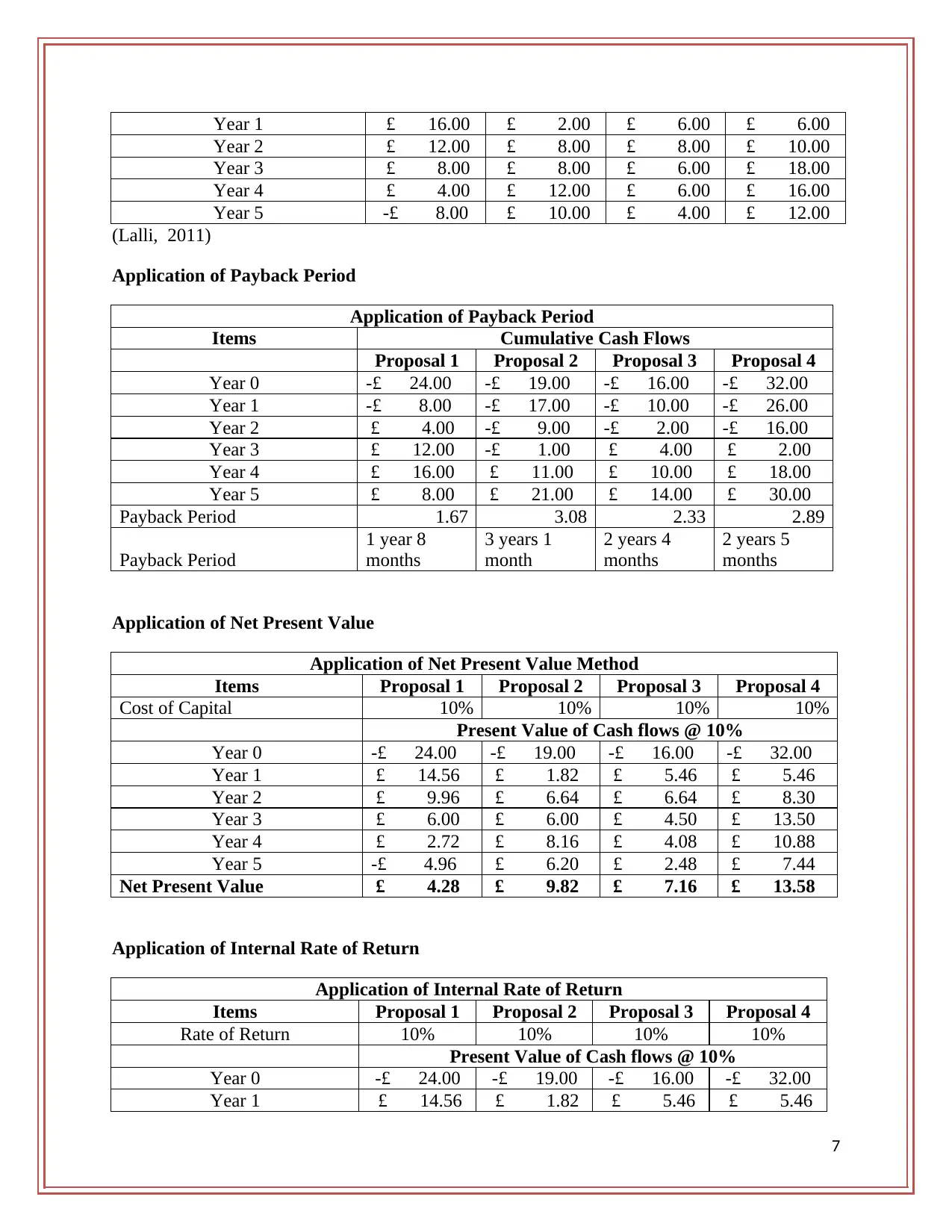
Year 1 £ 16.00 £ 2.00 £ 6.00 £ 6.00
Year 2 £ 12.00 £ 8.00 £ 8.00 £ 10.00
Year 3 £ 8.00 £ 8.00 £ 6.00 £ 18.00
Year 4 £ 4.00 £ 12.00 £ 6.00 £ 16.00
Year 5 -£ 8.00 £ 10.00 £ 4.00 £ 12.00
(Lalli, 2011)
Application of Payback Period
Application of Payback Period
Items Cumulative Cash Flows
Proposal 1 Proposal 2 Proposal 3 Proposal 4
Year 0 -£ 24.00 -£ 19.00 -£ 16.00 -£ 32.00
Year 1 -£ 8.00 -£ 17.00 -£ 10.00 -£ 26.00
Year 2 £ 4.00 -£ 9.00 -£ 2.00 -£ 16.00
Year 3 £ 12.00 -£ 1.00 £ 4.00 £ 2.00
Year 4 £ 16.00 £ 11.00 £ 10.00 £ 18.00
Year 5 £ 8.00 £ 21.00 £ 14.00 £ 30.00
Payback Period 1.67 3.08 2.33 2.89
Payback Period
1 year 8
months
3 years 1
month
2 years 4
months
2 years 5
months
Application of Net Present Value
Application of Net Present Value Method
Items Proposal 1 Proposal 2 Proposal 3 Proposal 4
Cost of Capital 10% 10% 10% 10%
Present Value of Cash flows @ 10%
Year 0 -£ 24.00 -£ 19.00 -£ 16.00 -£ 32.00
Year 1 £ 14.56 £ 1.82 £ 5.46 £ 5.46
Year 2 £ 9.96 £ 6.64 £ 6.64 £ 8.30
Year 3 £ 6.00 £ 6.00 £ 4.50 £ 13.50
Year 4 £ 2.72 £ 8.16 £ 4.08 £ 10.88
Year 5 -£ 4.96 £ 6.20 £ 2.48 £ 7.44
Net Present Value £ 4.28 £ 9.82 £ 7.16 £ 13.58
Application of Internal Rate of Return
Application of Internal Rate of Return
Items Proposal 1 Proposal 2 Proposal 3 Proposal 4
Rate of Return 10% 10% 10% 10%
Present Value of Cash flows @ 10%
Year 0 -£ 24.00 -£ 19.00 -£ 16.00 -£ 32.00
Year 1 £ 14.56 £ 1.82 £ 5.46 £ 5.46
7
Year 2 £ 12.00 £ 8.00 £ 8.00 £ 10.00
Year 3 £ 8.00 £ 8.00 £ 6.00 £ 18.00
Year 4 £ 4.00 £ 12.00 £ 6.00 £ 16.00
Year 5 -£ 8.00 £ 10.00 £ 4.00 £ 12.00
(Lalli, 2011)
Application of Payback Period
Application of Payback Period
Items Cumulative Cash Flows
Proposal 1 Proposal 2 Proposal 3 Proposal 4
Year 0 -£ 24.00 -£ 19.00 -£ 16.00 -£ 32.00
Year 1 -£ 8.00 -£ 17.00 -£ 10.00 -£ 26.00
Year 2 £ 4.00 -£ 9.00 -£ 2.00 -£ 16.00
Year 3 £ 12.00 -£ 1.00 £ 4.00 £ 2.00
Year 4 £ 16.00 £ 11.00 £ 10.00 £ 18.00
Year 5 £ 8.00 £ 21.00 £ 14.00 £ 30.00
Payback Period 1.67 3.08 2.33 2.89
Payback Period
1 year 8
months
3 years 1
month
2 years 4
months
2 years 5
months
Application of Net Present Value
Application of Net Present Value Method
Items Proposal 1 Proposal 2 Proposal 3 Proposal 4
Cost of Capital 10% 10% 10% 10%
Present Value of Cash flows @ 10%
Year 0 -£ 24.00 -£ 19.00 -£ 16.00 -£ 32.00
Year 1 £ 14.56 £ 1.82 £ 5.46 £ 5.46
Year 2 £ 9.96 £ 6.64 £ 6.64 £ 8.30
Year 3 £ 6.00 £ 6.00 £ 4.50 £ 13.50
Year 4 £ 2.72 £ 8.16 £ 4.08 £ 10.88
Year 5 -£ 4.96 £ 6.20 £ 2.48 £ 7.44
Net Present Value £ 4.28 £ 9.82 £ 7.16 £ 13.58
Application of Internal Rate of Return
Application of Internal Rate of Return
Items Proposal 1 Proposal 2 Proposal 3 Proposal 4
Rate of Return 10% 10% 10% 10%
Present Value of Cash flows @ 10%
Year 0 -£ 24.00 -£ 19.00 -£ 16.00 -£ 32.00
Year 1 £ 14.56 £ 1.82 £ 5.46 £ 5.46
7
Paraphrase This Document
Need a fresh take? Get an instant paraphrase of this document with our AI Paraphraser
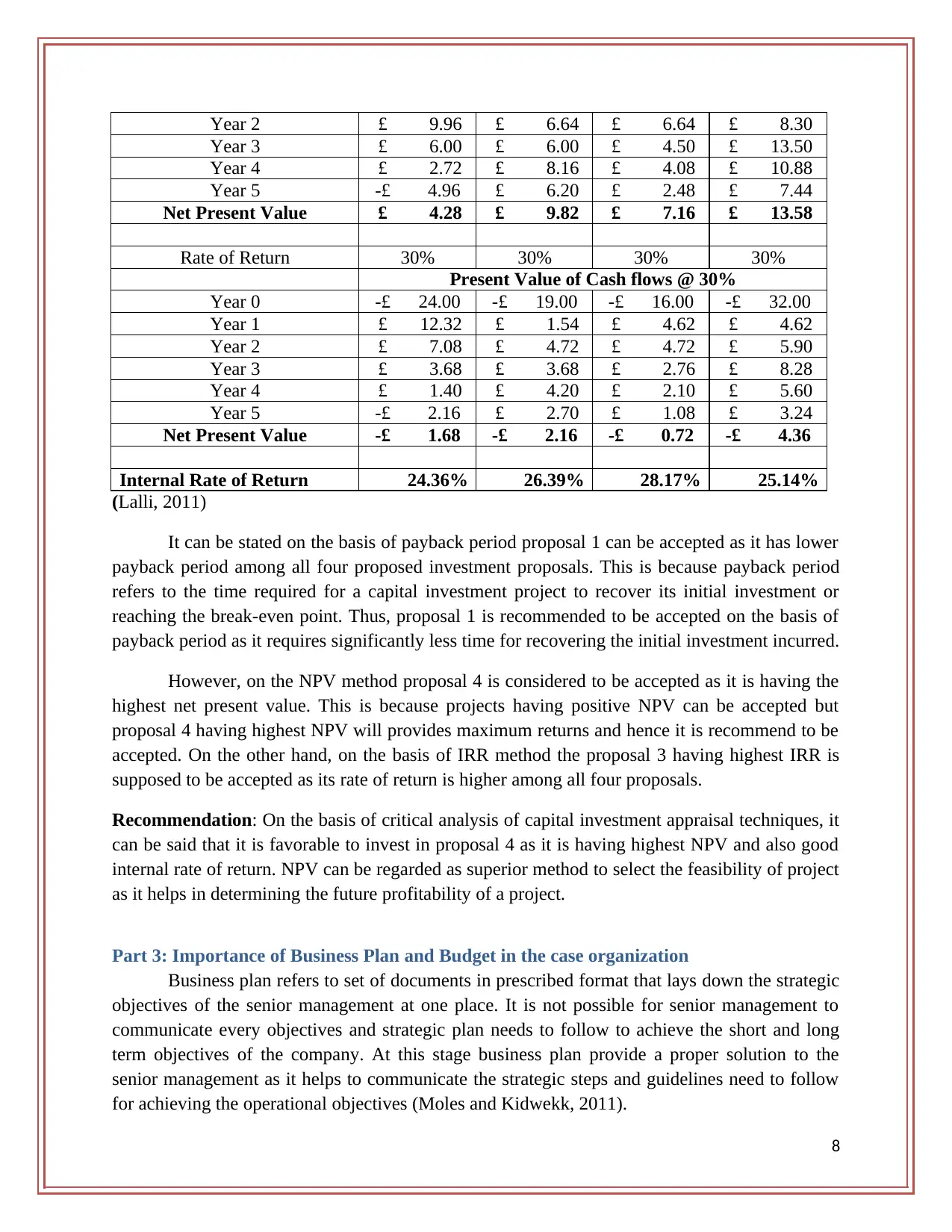
Year 2 £ 9.96 £ 6.64 £ 6.64 £ 8.30
Year 3 £ 6.00 £ 6.00 £ 4.50 £ 13.50
Year 4 £ 2.72 £ 8.16 £ 4.08 £ 10.88
Year 5 -£ 4.96 £ 6.20 £ 2.48 £ 7.44
Net Present Value £ 4.28 £ 9.82 £ 7.16 £ 13.58
Rate of Return 30% 30% 30% 30%
Present Value of Cash flows @ 30%
Year 0 -£ 24.00 -£ 19.00 -£ 16.00 -£ 32.00
Year 1 £ 12.32 £ 1.54 £ 4.62 £ 4.62
Year 2 £ 7.08 £ 4.72 £ 4.72 £ 5.90
Year 3 £ 3.68 £ 3.68 £ 2.76 £ 8.28
Year 4 £ 1.40 £ 4.20 £ 2.10 £ 5.60
Year 5 -£ 2.16 £ 2.70 £ 1.08 £ 3.24
Net Present Value -£ 1.68 -£ 2.16 -£ 0.72 -£ 4.36
Internal Rate of Return 24.36% 26.39% 28.17% 25.14%
(Lalli, 2011)
It can be stated on the basis of payback period proposal 1 can be accepted as it has lower
payback period among all four proposed investment proposals. This is because payback period
refers to the time required for a capital investment project to recover its initial investment or
reaching the break-even point. Thus, proposal 1 is recommended to be accepted on the basis of
payback period as it requires significantly less time for recovering the initial investment incurred.
However, on the NPV method proposal 4 is considered to be accepted as it is having the
highest net present value. This is because projects having positive NPV can be accepted but
proposal 4 having highest NPV will provides maximum returns and hence it is recommend to be
accepted. On the other hand, on the basis of IRR method the proposal 3 having highest IRR is
supposed to be accepted as its rate of return is higher among all four proposals.
Recommendation: On the basis of critical analysis of capital investment appraisal techniques, it
can be said that it is favorable to invest in proposal 4 as it is having highest NPV and also good
internal rate of return. NPV can be regarded as superior method to select the feasibility of project
as it helps in determining the future profitability of a project.
Part 3: Importance of Business Plan and Budget in the case organization
Business plan refers to set of documents in prescribed format that lays down the strategic
objectives of the senior management at one place. It is not possible for senior management to
communicate every objectives and strategic plan needs to follow to achieve the short and long
term objectives of the company. At this stage business plan provide a proper solution to the
senior management as it helps to communicate the strategic steps and guidelines need to follow
for achieving the operational objectives (Moles and Kidwekk, 2011).
8
Year 3 £ 6.00 £ 6.00 £ 4.50 £ 13.50
Year 4 £ 2.72 £ 8.16 £ 4.08 £ 10.88
Year 5 -£ 4.96 £ 6.20 £ 2.48 £ 7.44
Net Present Value £ 4.28 £ 9.82 £ 7.16 £ 13.58
Rate of Return 30% 30% 30% 30%
Present Value of Cash flows @ 30%
Year 0 -£ 24.00 -£ 19.00 -£ 16.00 -£ 32.00
Year 1 £ 12.32 £ 1.54 £ 4.62 £ 4.62
Year 2 £ 7.08 £ 4.72 £ 4.72 £ 5.90
Year 3 £ 3.68 £ 3.68 £ 2.76 £ 8.28
Year 4 £ 1.40 £ 4.20 £ 2.10 £ 5.60
Year 5 -£ 2.16 £ 2.70 £ 1.08 £ 3.24
Net Present Value -£ 1.68 -£ 2.16 -£ 0.72 -£ 4.36
Internal Rate of Return 24.36% 26.39% 28.17% 25.14%
(Lalli, 2011)
It can be stated on the basis of payback period proposal 1 can be accepted as it has lower
payback period among all four proposed investment proposals. This is because payback period
refers to the time required for a capital investment project to recover its initial investment or
reaching the break-even point. Thus, proposal 1 is recommended to be accepted on the basis of
payback period as it requires significantly less time for recovering the initial investment incurred.
However, on the NPV method proposal 4 is considered to be accepted as it is having the
highest net present value. This is because projects having positive NPV can be accepted but
proposal 4 having highest NPV will provides maximum returns and hence it is recommend to be
accepted. On the other hand, on the basis of IRR method the proposal 3 having highest IRR is
supposed to be accepted as its rate of return is higher among all four proposals.
Recommendation: On the basis of critical analysis of capital investment appraisal techniques, it
can be said that it is favorable to invest in proposal 4 as it is having highest NPV and also good
internal rate of return. NPV can be regarded as superior method to select the feasibility of project
as it helps in determining the future profitability of a project.
Part 3: Importance of Business Plan and Budget in the case organization
Business plan refers to set of documents in prescribed format that lays down the strategic
objectives of the senior management at one place. It is not possible for senior management to
communicate every objectives and strategic plan needs to follow to achieve the short and long
term objectives of the company. At this stage business plan provide a proper solution to the
senior management as it helps to communicate the strategic steps and guidelines need to follow
for achieving the operational objectives (Moles and Kidwekk, 2011).
8
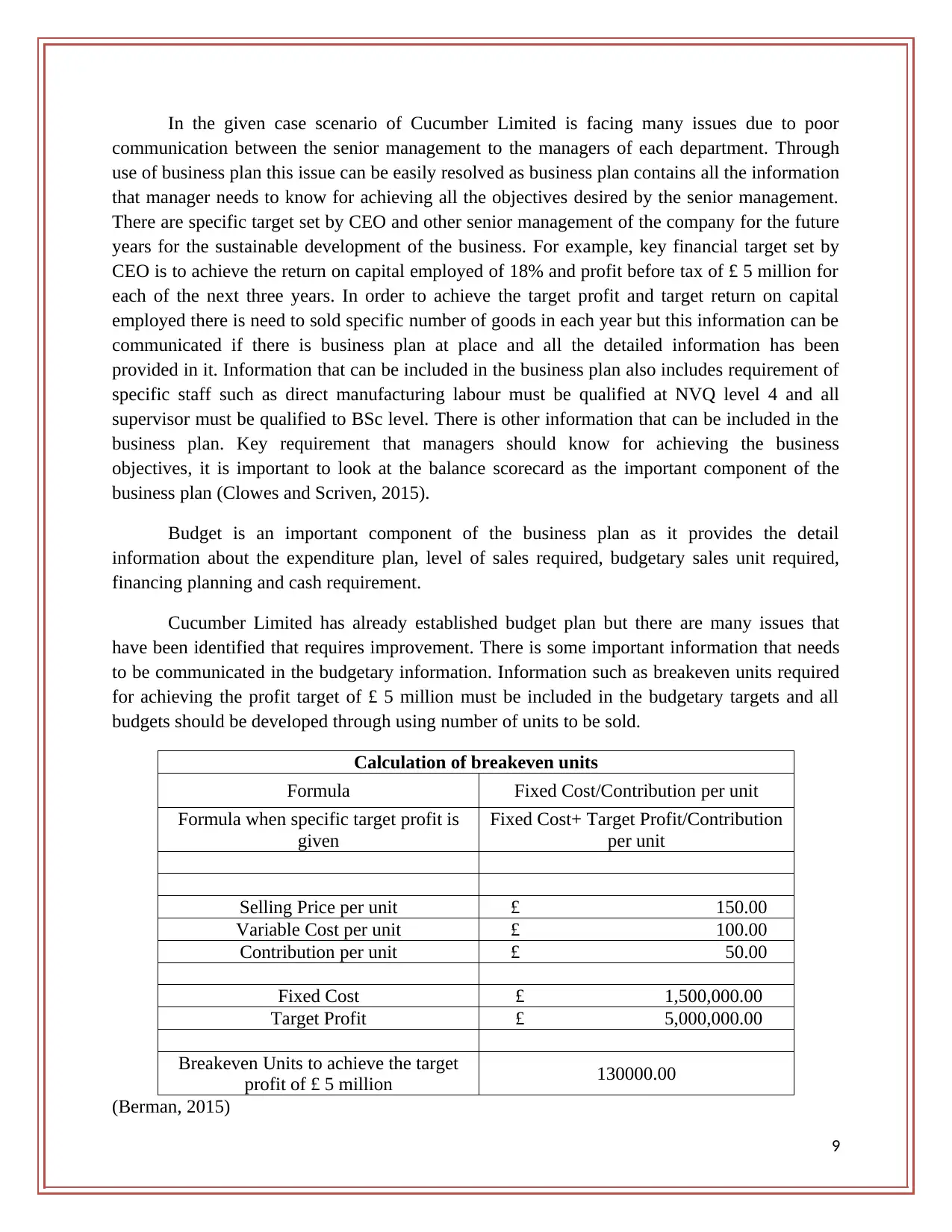
In the given case scenario of Cucumber Limited is facing many issues due to poor
communication between the senior management to the managers of each department. Through
use of business plan this issue can be easily resolved as business plan contains all the information
that manager needs to know for achieving all the objectives desired by the senior management.
There are specific target set by CEO and other senior management of the company for the future
years for the sustainable development of the business. For example, key financial target set by
CEO is to achieve the return on capital employed of 18% and profit before tax of £ 5 million for
each of the next three years. In order to achieve the target profit and target return on capital
employed there is need to sold specific number of goods in each year but this information can be
communicated if there is business plan at place and all the detailed information has been
provided in it. Information that can be included in the business plan also includes requirement of
specific staff such as direct manufacturing labour must be qualified at NVQ level 4 and all
supervisor must be qualified to BSc level. There is other information that can be included in the
business plan. Key requirement that managers should know for achieving the business
objectives, it is important to look at the balance scorecard as the important component of the
business plan (Clowes and Scriven, 2015).
Budget is an important component of the business plan as it provides the detail
information about the expenditure plan, level of sales required, budgetary sales unit required,
financing planning and cash requirement.
Cucumber Limited has already established budget plan but there are many issues that
have been identified that requires improvement. There is some important information that needs
to be communicated in the budgetary information. Information such as breakeven units required
for achieving the profit target of £ 5 million must be included in the budgetary targets and all
budgets should be developed through using number of units to be sold.
Calculation of breakeven units
Formula Fixed Cost/Contribution per unit
Formula when specific target profit is
given
Fixed Cost+ Target Profit/Contribution
per unit
Selling Price per unit £ 150.00
Variable Cost per unit £ 100.00
Contribution per unit £ 50.00
Fixed Cost £ 1,500,000.00
Target Profit £ 5,000,000.00
Breakeven Units to achieve the target
profit of £ 5 million 130000.00
(Berman, 2015)
9
communication between the senior management to the managers of each department. Through
use of business plan this issue can be easily resolved as business plan contains all the information
that manager needs to know for achieving all the objectives desired by the senior management.
There are specific target set by CEO and other senior management of the company for the future
years for the sustainable development of the business. For example, key financial target set by
CEO is to achieve the return on capital employed of 18% and profit before tax of £ 5 million for
each of the next three years. In order to achieve the target profit and target return on capital
employed there is need to sold specific number of goods in each year but this information can be
communicated if there is business plan at place and all the detailed information has been
provided in it. Information that can be included in the business plan also includes requirement of
specific staff such as direct manufacturing labour must be qualified at NVQ level 4 and all
supervisor must be qualified to BSc level. There is other information that can be included in the
business plan. Key requirement that managers should know for achieving the business
objectives, it is important to look at the balance scorecard as the important component of the
business plan (Clowes and Scriven, 2015).
Budget is an important component of the business plan as it provides the detail
information about the expenditure plan, level of sales required, budgetary sales unit required,
financing planning and cash requirement.
Cucumber Limited has already established budget plan but there are many issues that
have been identified that requires improvement. There is some important information that needs
to be communicated in the budgetary information. Information such as breakeven units required
for achieving the profit target of £ 5 million must be included in the budgetary targets and all
budgets should be developed through using number of units to be sold.
Calculation of breakeven units
Formula Fixed Cost/Contribution per unit
Formula when specific target profit is
given
Fixed Cost+ Target Profit/Contribution
per unit
Selling Price per unit £ 150.00
Variable Cost per unit £ 100.00
Contribution per unit £ 50.00
Fixed Cost £ 1,500,000.00
Target Profit £ 5,000,000.00
Breakeven Units to achieve the target
profit of £ 5 million 130000.00
(Berman, 2015)
9

Areas need to be improved in budgetary control process:
It is required to provide the variance report on 1 st day of next month for which report has
been prepared. For example, for month of September, report must be given on 1st
October.
Variance report must be adjusted for number of units sold in respective month
Below is the correct variance report for the September month:
Productive Activity Budget Budget Actual Variance
3000 4000
4,000
units
Costs £ £ £ %
Materials 31000 41333.33 39000 2333.33 Favorable 8%
Supplies 11000 14666.67 12500 2166.67 Favorable 20%
Direct Labour 9000 12000.00 9500 2500.00 Favorable 28%
Indirect labour 5000 6666.67 5200 1466.67 Favorable 29%
Depreciation 2000 2000.00 2000 0.00 0%
0.00
Share of Sales costs 2500 3333.33 2800 533.33 Favorable 21%
0.00
Apportioned overhead 10000 13333.33 15000 -1666.67 Adverse -17%
Total 70500 93333.33 86000 7333.33 Favorable 10%
(Adler, 2013)
Part 4: Critically discussion of the usefulness of Balanced Scorecard Approach and
development of Balance Scorecard for Cucumber Ltd
The Balance Scorecard (BSC) is regarded as a strategic planning and management tool
that can be used by businesses for measuring and monitoring their progress towards the
achievement of the strategic targets. It evaluates the performance of an organization on the basis
of four perspectives, that are, financial, customer, internal business and learning and growth
perspectives. The BSC approach can be used by organizations for developing the long-term
strategic goals and aligning them with short-term strategic plans. The business organizations can
develop their key performance indicators on the basis of strategic goals and objectives created
with the use of BSC approach. The businesses adopting the use of this management tool are also
bale to develop and report higher quality of information to the management for aiding their
decision-making. It can also enable the businesses to improve the transparency and reliability
within their management reports and ensuring that information provided is trustworthy for
developing the strategic plans of future business growth and development. It can also be
regarded as an effective way for visualizing the financial as well as non-financial performance of
a company before the senior management people and developing the long-term strategic goals.
10
It is required to provide the variance report on 1 st day of next month for which report has
been prepared. For example, for month of September, report must be given on 1st
October.
Variance report must be adjusted for number of units sold in respective month
Below is the correct variance report for the September month:
Productive Activity Budget Budget Actual Variance
3000 4000
4,000
units
Costs £ £ £ %
Materials 31000 41333.33 39000 2333.33 Favorable 8%
Supplies 11000 14666.67 12500 2166.67 Favorable 20%
Direct Labour 9000 12000.00 9500 2500.00 Favorable 28%
Indirect labour 5000 6666.67 5200 1466.67 Favorable 29%
Depreciation 2000 2000.00 2000 0.00 0%
0.00
Share of Sales costs 2500 3333.33 2800 533.33 Favorable 21%
0.00
Apportioned overhead 10000 13333.33 15000 -1666.67 Adverse -17%
Total 70500 93333.33 86000 7333.33 Favorable 10%
(Adler, 2013)
Part 4: Critically discussion of the usefulness of Balanced Scorecard Approach and
development of Balance Scorecard for Cucumber Ltd
The Balance Scorecard (BSC) is regarded as a strategic planning and management tool
that can be used by businesses for measuring and monitoring their progress towards the
achievement of the strategic targets. It evaluates the performance of an organization on the basis
of four perspectives, that are, financial, customer, internal business and learning and growth
perspectives. The BSC approach can be used by organizations for developing the long-term
strategic goals and aligning them with short-term strategic plans. The business organizations can
develop their key performance indicators on the basis of strategic goals and objectives created
with the use of BSC approach. The businesses adopting the use of this management tool are also
bale to develop and report higher quality of information to the management for aiding their
decision-making. It can also enable the businesses to improve the transparency and reliability
within their management reports and ensuring that information provided is trustworthy for
developing the strategic plans of future business growth and development. It can also be
regarded as an effective way for visualizing the financial as well as non-financial performance of
a company before the senior management people and developing the long-term strategic goals.
10
Secure Best Marks with AI Grader
Need help grading? Try our AI Grader for instant feedback on your assignments.
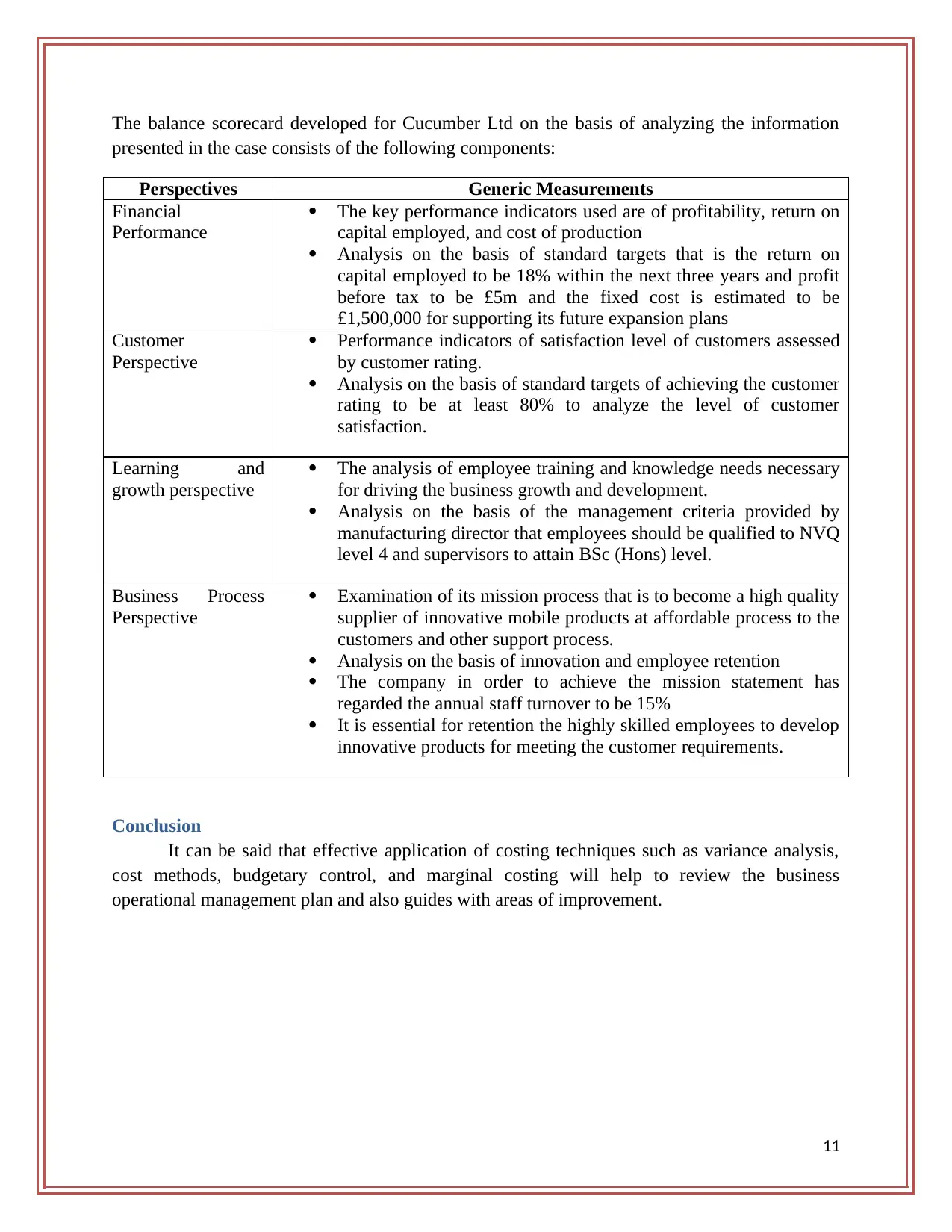
The balance scorecard developed for Cucumber Ltd on the basis of analyzing the information
presented in the case consists of the following components:
Perspectives Generic Measurements
Financial
Performance
The key performance indicators used are of profitability, return on
capital employed, and cost of production
Analysis on the basis of standard targets that is the return on
capital employed to be 18% within the next three years and profit
before tax to be £5m and the fixed cost is estimated to be
£1,500,000 for supporting its future expansion plans
Customer
Perspective
Performance indicators of satisfaction level of customers assessed
by customer rating.
Analysis on the basis of standard targets of achieving the customer
rating to be at least 80% to analyze the level of customer
satisfaction.
Learning and
growth perspective
The analysis of employee training and knowledge needs necessary
for driving the business growth and development.
Analysis on the basis of the management criteria provided by
manufacturing director that employees should be qualified to NVQ
level 4 and supervisors to attain BSc (Hons) level.
Business Process
Perspective
Examination of its mission process that is to become a high quality
supplier of innovative mobile products at affordable process to the
customers and other support process.
Analysis on the basis of innovation and employee retention
The company in order to achieve the mission statement has
regarded the annual staff turnover to be 15%
It is essential for retention the highly skilled employees to develop
innovative products for meeting the customer requirements.
Conclusion
It can be said that effective application of costing techniques such as variance analysis,
cost methods, budgetary control, and marginal costing will help to review the business
operational management plan and also guides with areas of improvement.
11
presented in the case consists of the following components:
Perspectives Generic Measurements
Financial
Performance
The key performance indicators used are of profitability, return on
capital employed, and cost of production
Analysis on the basis of standard targets that is the return on
capital employed to be 18% within the next three years and profit
before tax to be £5m and the fixed cost is estimated to be
£1,500,000 for supporting its future expansion plans
Customer
Perspective
Performance indicators of satisfaction level of customers assessed
by customer rating.
Analysis on the basis of standard targets of achieving the customer
rating to be at least 80% to analyze the level of customer
satisfaction.
Learning and
growth perspective
The analysis of employee training and knowledge needs necessary
for driving the business growth and development.
Analysis on the basis of the management criteria provided by
manufacturing director that employees should be qualified to NVQ
level 4 and supervisors to attain BSc (Hons) level.
Business Process
Perspective
Examination of its mission process that is to become a high quality
supplier of innovative mobile products at affordable process to the
customers and other support process.
Analysis on the basis of innovation and employee retention
The company in order to achieve the mission statement has
regarded the annual staff turnover to be 15%
It is essential for retention the highly skilled employees to develop
innovative products for meeting the customer requirements.
Conclusion
It can be said that effective application of costing techniques such as variance analysis,
cost methods, budgetary control, and marginal costing will help to review the business
operational management plan and also guides with areas of improvement.
11
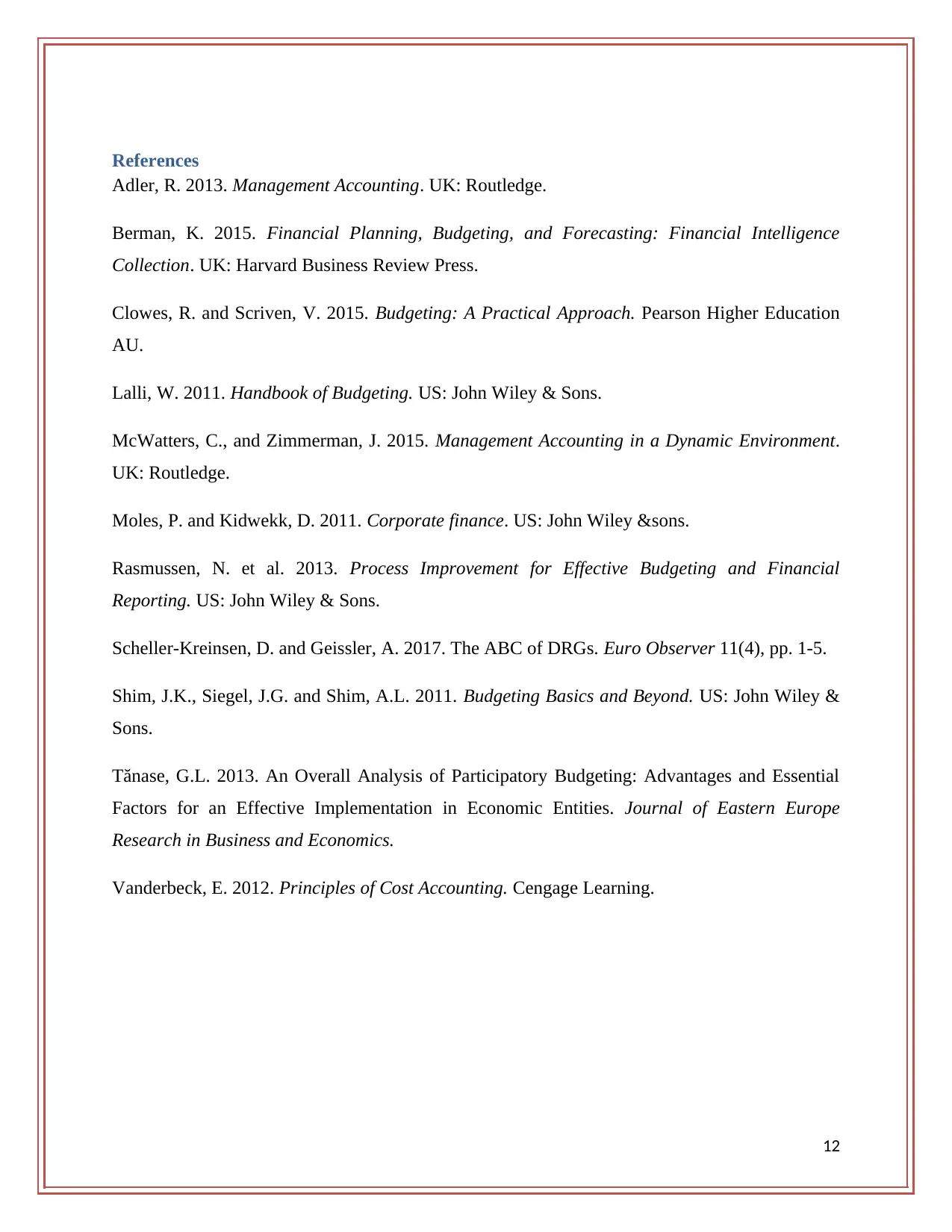
References
Adler, R. 2013. Management Accounting. UK: Routledge.
Berman, K. 2015. Financial Planning, Budgeting, and Forecasting: Financial Intelligence
Collection. UK: Harvard Business Review Press.
Clowes, R. and Scriven, V. 2015. Budgeting: A Practical Approach. Pearson Higher Education
AU.
Lalli, W. 2011. Handbook of Budgeting. US: John Wiley & Sons.
McWatters, C., and Zimmerman, J. 2015. Management Accounting in a Dynamic Environment.
UK: Routledge.
Moles, P. and Kidwekk, D. 2011. Corporate finance. US: John Wiley &sons.
Rasmussen, N. et al. 2013. Process Improvement for Effective Budgeting and Financial
Reporting. US: John Wiley & Sons.
Scheller-Kreinsen, D. and Geissler, A. 2017. The ABC of DRGs. Euro Observer 11(4), pp. 1-5.
Shim, J.K., Siegel, J.G. and Shim, A.L. 2011. Budgeting Basics and Beyond. US: John Wiley &
Sons.
Tănase, G.L. 2013. An Overall Analysis of Participatory Budgeting: Advantages and Essential
Factors for an Effective Implementation in Economic Entities. Journal of Eastern Europe
Research in Business and Economics.
Vanderbeck, E. 2012. Principles of Cost Accounting. Cengage Learning.
12
Adler, R. 2013. Management Accounting. UK: Routledge.
Berman, K. 2015. Financial Planning, Budgeting, and Forecasting: Financial Intelligence
Collection. UK: Harvard Business Review Press.
Clowes, R. and Scriven, V. 2015. Budgeting: A Practical Approach. Pearson Higher Education
AU.
Lalli, W. 2011. Handbook of Budgeting. US: John Wiley & Sons.
McWatters, C., and Zimmerman, J. 2015. Management Accounting in a Dynamic Environment.
UK: Routledge.
Moles, P. and Kidwekk, D. 2011. Corporate finance. US: John Wiley &sons.
Rasmussen, N. et al. 2013. Process Improvement for Effective Budgeting and Financial
Reporting. US: John Wiley & Sons.
Scheller-Kreinsen, D. and Geissler, A. 2017. The ABC of DRGs. Euro Observer 11(4), pp. 1-5.
Shim, J.K., Siegel, J.G. and Shim, A.L. 2011. Budgeting Basics and Beyond. US: John Wiley &
Sons.
Tănase, G.L. 2013. An Overall Analysis of Participatory Budgeting: Advantages and Essential
Factors for an Effective Implementation in Economic Entities. Journal of Eastern Europe
Research in Business and Economics.
Vanderbeck, E. 2012. Principles of Cost Accounting. Cengage Learning.
12
1 out of 12
Related Documents
Your All-in-One AI-Powered Toolkit for Academic Success.
+13062052269
info@desklib.com
Available 24*7 on WhatsApp / Email
![[object Object]](/_next/static/media/star-bottom.7253800d.svg)
Unlock your academic potential
© 2024 | Zucol Services PVT LTD | All rights reserved.





